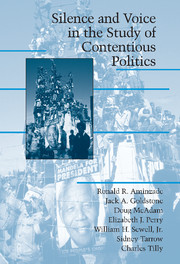Book contents
- Frontmatter
- Contents
- Preface
- 1 SILENCE AND VOICE IN THE STUDY OF CONTENTIOUS POLITICS: INTRODUCTION
- 2 EMOTIONS AND CONTENTIOUS POLITICS
- 3 SPACE IN CONTENTIOUS POLITICS
- 4 IT'S ABOUT TIME: TEMPORALITY IN THE STUDY OF SOCIAL MOVEMENTS AND REVOLUTIONS
- 5 LEADERSHIP DYNAMICS AND DYNAMICS OF CONTENTION
- 6 THE SACRED, RELIGIOUS, AND SECULAR IN CONTENTIOUS POLITICS: BLURRING BOUNDARIES
- 7 THREAT (AND OPPORTUNITY): POPULAR ACTION AND STATE RESPONSE IN THE DYNAMICS OF CONTENTIOUS ACTION
- 8 CONTENTION IN DEMOGRAPHIC AND LIFE-COURSE CONTEXT
- 9 HARMONIZING THE VOICES: THEMATIC CONTINUITY ACROSS THE CHAPTERS
- References
- Index
2 - EMOTIONS AND CONTENTIOUS POLITICS
Published online by Cambridge University Press: 05 June 2012
- Frontmatter
- Contents
- Preface
- 1 SILENCE AND VOICE IN THE STUDY OF CONTENTIOUS POLITICS: INTRODUCTION
- 2 EMOTIONS AND CONTENTIOUS POLITICS
- 3 SPACE IN CONTENTIOUS POLITICS
- 4 IT'S ABOUT TIME: TEMPORALITY IN THE STUDY OF SOCIAL MOVEMENTS AND REVOLUTIONS
- 5 LEADERSHIP DYNAMICS AND DYNAMICS OF CONTENTION
- 6 THE SACRED, RELIGIOUS, AND SECULAR IN CONTENTIOUS POLITICS: BLURRING BOUNDARIES
- 7 THREAT (AND OPPORTUNITY): POPULAR ACTION AND STATE RESPONSE IN THE DYNAMICS OF CONTENTIOUS ACTION
- 8 CONTENTION IN DEMOGRAPHIC AND LIFE-COURSE CONTEXT
- 9 HARMONIZING THE VOICES: THEMATIC CONTINUITY ACROSS THE CHAPTERS
- References
- Index
Summary
In all fields of study, dominant theoretical perspectives tend to obscure as much as they reveal. By highlighting specific dimensions of complex empirical phenomena, leading paradigms render other aspects of these same phenomena more or less invisible to scholars. This is no less true of the study of contentious politics than it is of other fields of inquiry. Focusing only on the more narrow literature on social movements, we find that the recent dominance of what might be termed “structural environmental” perspectives (for example, resource mobilization, political process, and so on) has tended to focus attention on the environmental facilitation or suppression of movement activity rather than on internal characteristics or dynamics of the movements themselves.
In this chapter we want to take up one especially notable “silence” in the social movement literature as it pertains to internal movement dynamics. We are referring to the mobilization of emotions as a necessary and exceedingly important component of any significant instance of collective action. Our aims in this regard are modest. Given the lack of systematic work in this area, we hope simply to: (1) Highlight this “silence” for other researchers; (2) parse the literature on the sociology of emotions for insights relevant to the study of social movements; and, (3) in a nonsystematic way, describe, what to us, seem like some of the critically important aggregate level emotional processes/dynamics that shape the ebb and flow of protest activity.
- Type
- Chapter
- Information
- Silence and Voice in the Study of Contentious Politics , pp. 14 - 50Publisher: Cambridge University PressPrint publication year: 2001
- 130
- Cited by

